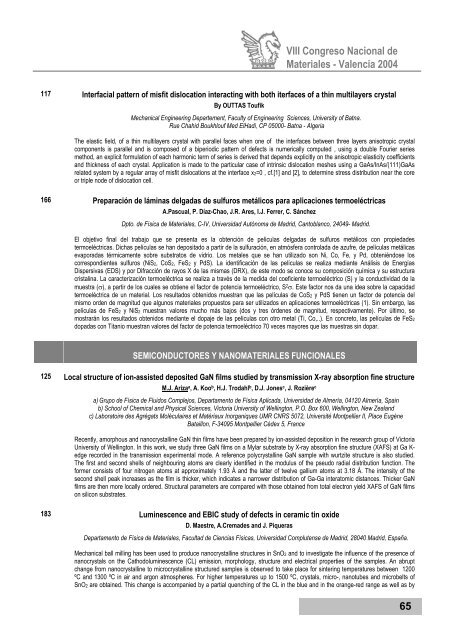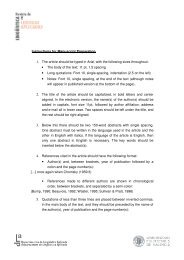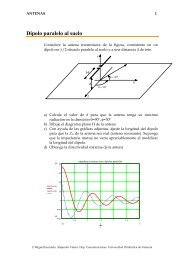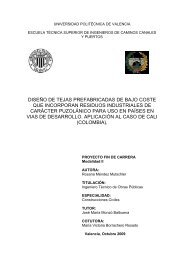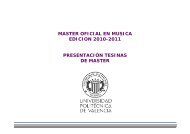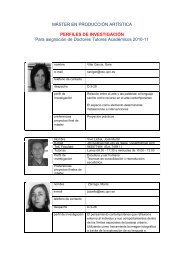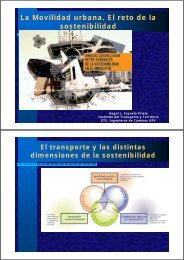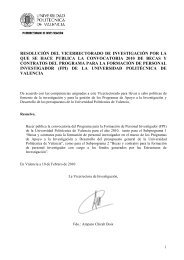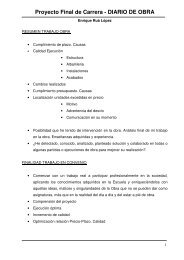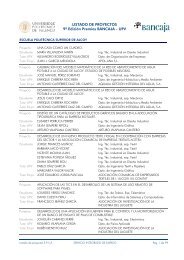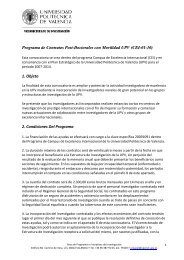materiales cerámicos. síntesis y procesado - Universidad ...
materiales cerámicos. síntesis y procesado - Universidad ...
materiales cerámicos. síntesis y procesado - Universidad ...
Create successful ePaper yourself
Turn your PDF publications into a flip-book with our unique Google optimized e-Paper software.
VIII Congreso Nacional de<br />
Materiales - Valencia 2004<br />
117 Interfacial pattern of misfit dislocation interacting with both iterfaces of a thin multilayers crystal<br />
By OUTTAS Toufik<br />
Mechanical Engineering Departement, Faculty of Engineering Sciences, University of Batna.<br />
Rue Chahid Boukhlouf Med ElHadi, CP 05000- Batna - Algeria<br />
The elastic field, of a thin multilayers crystal with parallel faces when one of the interfaces between three layers anisotropic crystal<br />
components is parallel and is composed of a biperiodic pattern of defects is numerically computed , using a double Fourier series<br />
method, an explicit formulation of each harmonic term of series is derived that depends explicitly on the anisotropic elasticity coefficients<br />
and thickness of each crystal. Application is made to the particular case of intrinsic dislocation meshes using a GaAs/InAs/(111)GaAs<br />
related system by a regular array of misfit dislocations at the interface x2=0 , cf.[1] and [2], to determine stress distribution near the core<br />
or triple node of dislocation cell.<br />
166 Preparación de láminas delgadas de sulfuros metálicos para aplicaciones termoeléctricas<br />
A.Pascual, P. Díaz-Chao, J.R. Ares, I.J. Ferrer, C. Sánchez<br />
Dpto. de Física de Materiales, C-IV, <strong>Universidad</strong> Autónoma de Madrid, Cantoblanco, 24049- Madrid.<br />
El objetivo final del trabajo que se presenta es la obtención de películas delgadas de sulfuros metálicos con propiedades<br />
termoeléctricas. Dichas películas se han depositado a partir de la sulfuración, en atmósfera controlada de azufre, de películas metálicas<br />
evaporadas térmicamente sobre substratos de vidrio. Los metales que se han utilizado son Ni, Co, Fe, y Pd, obteniéndose los<br />
correspondientes sulfuros (NiS2, CoS2, FeS2 y PdS). La identificación de las películas se realiza mediante Análisis de Energías<br />
Dispersivas (EDS) y por Difracción de rayos X de las mismas (DRX), de este modo se conoce su composición química y su estructura<br />
cristalina. La caracterización termoeléctrica se realiza a través de la medida del coeficiente termoeléctrico (S) y la conductividad de la<br />
muestra (σ), a partir de los cuales se obtiene el factor de potencia termoeléctrico, S 2 σ. Este factor nos da una idea sobre la capacidad<br />
termoeléctrica de un material. Los resultados obtenidos muestran que las películas de CoS2 y PdS tienen un factor de potencia del<br />
mismo orden de magnitud que algunos <strong>materiales</strong> propuestos para ser utilizados en aplicaciones termoeléctricas (1). Sin embargo, las<br />
películas de FeS2 y NiS2 muestran valores mucho más bajos (dos y tres órdenes de magnitud, respectivamente). Por último, se<br />
mostrarán los resultados obtenidos mediante el dopaje de las películas con otro metal (Ti, Co,..). En concreto, las películas de FeS2<br />
dopadas con Titanio muestran valores del factor de potencia termoeléctrico 70 veces mayores que las muestras sin dopar.<br />
SEMICONDUCTORES Y NANOMATERIALES FUNCIONALES<br />
125 Local structure of ion-assisted deposited GaN films studied by transmission X-ray absorption fine structure<br />
M.J. Arizaa , A. Koob , H.J. Trodahlb , D.J. Jonesc , J. Rozièrec a) Grupo de Física de Fluidos Complejos, Departamento de Física Aplicada, <strong>Universidad</strong> de Almería, 04120 Almería, Spain<br />
b) School of Chemical and Physical Sciences, Victoria University of Wellington, P.O. Box 600, Wellington, New Zealand<br />
c) Laboratoire des Agrégats Moléculaires et Matériaux Inorganiques UMR CNRS 5072, Université Montpellier II, Place Eugène<br />
Bataillon, F-34095 Montpellier Cédex 5, France<br />
Recently, amorphous and nanocrystalline GaN thin films have been prepared by ion-assisted deposition in the research group of Victoria<br />
University of Wellington. In this work, we study three GaN films on a Mylar substrate by X-ray absorption fine structure (XAFS) at Ga Kedge<br />
recorded in the transmission experimental mode. A reference polycrystalline GaN sample with wurtzite structure is also studied.<br />
The first and second shells of neighbouring atoms are clearly identified in the modulus of the pseudo radial distribution function. The<br />
former consists of four nitrogen atoms at approximately 1.93 Å and the latter of twelve gallium atoms at 3.18 Å. The intensity of the<br />
second shell peak increases as the film is thicker, which indicates a narrower distribution of Ga-Ga interatomic distances. Thicker GaN<br />
films are then more locally ordered. Structural parameters are compared with those obtained from total electron yield XAFS of GaN films<br />
on silicon substrates.<br />
183 Luminescence and EBIC study of defects in ceramic tin oxide<br />
D. Maestre, A.Cremades and J. Piqueras<br />
Departamento de Física de Materiales, Facultad de Ciencias Físicas, <strong>Universidad</strong> Complutense de Madrid, 28040 Madrid, España.<br />
Mechanical ball milling has been used to produce nanocrystalline structures in SnO2 and to investigate the influence of the presence of<br />
nanocrystals on the Cathodoluminescence (CL) emission, morphology, structure and electrical properties of the samples. An abrupt<br />
change from nanocrystalline to microcrystalline structured samples is observed to take place for sintering temperatures between 1200<br />
ºC and 1300 ºC in air and argon atmospheres. For higher temperatures up to 1500 ºC, crystals, micro-, nanotubes and microbelts of<br />
SnO2 are obtained. This change is accompanied by a partial quenching of the CL in the blue and in the orange-red range as well as by<br />
65


